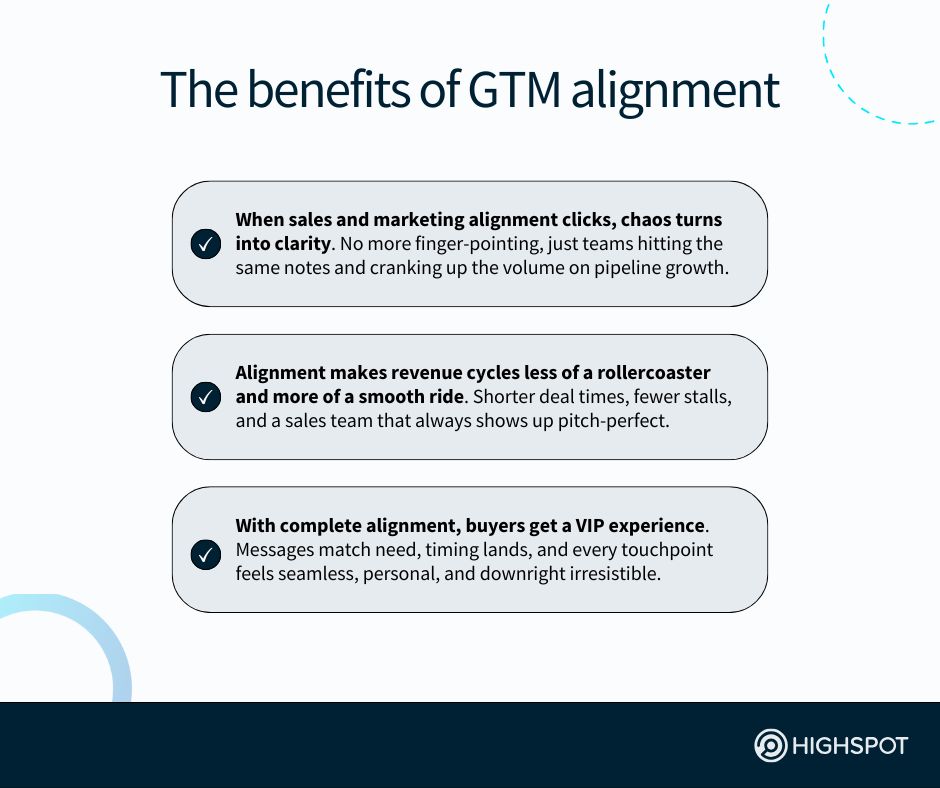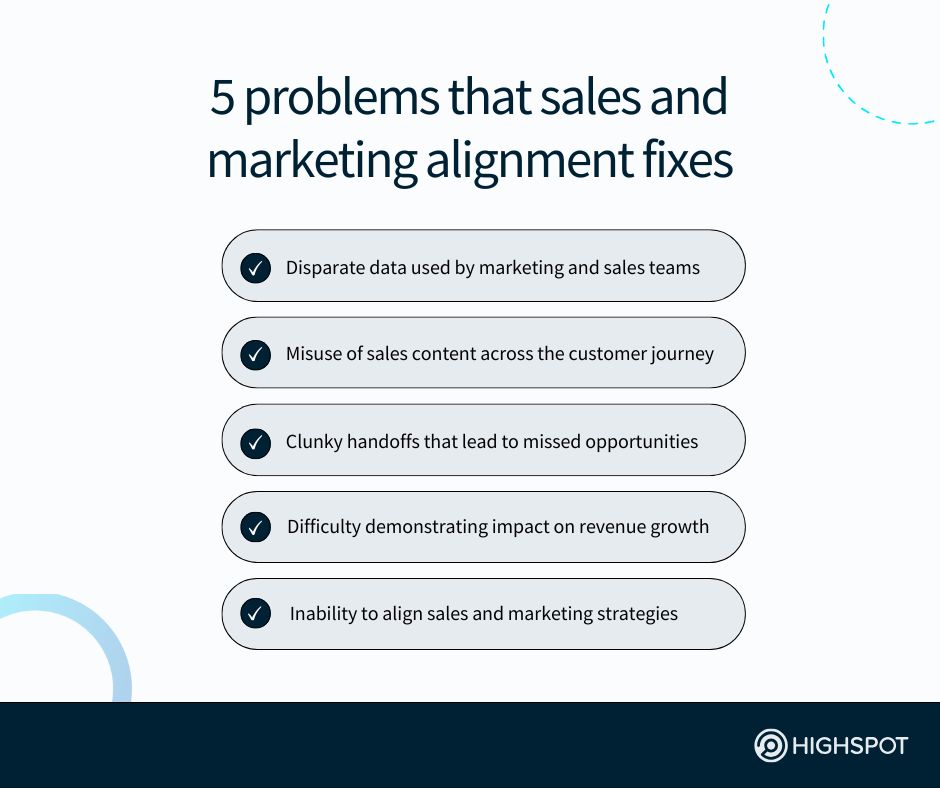Key Takeaways
- Sales and marketing alignment means fewer crossed wires, more closed deals, and a pipeline that delivers consistently strong results. Go-to-market (GTM) messaging and motions must match for momentum to follow.
- When sales and marketing share data, goals, and coffee breaks, you stop playing catch-up and start playing offense. Close coordination among these functions is how you win in competitive, fast-moving markets.
- If your sales and marketing professionals are guessing what each other needs, you’ve already lost time and traction. Give them a shared rhythm, a clear view of impact, and watch them move the market together.
Often sought and rarely achieved, sales and marketing alignment is the holy grail of go-to-market teams at every B2B organisation. And it’s no wonder why.
Successful sales and marketing teams that are always on the same page:
- Elevate pipeline quality by aligning content and campaigns to real demand
- Boost win rates by ensuring reps share the right message at the right time
- Reduce wasted spend low-impact lead-generation and -nurturing tactics
- Speed up sales cycles with cleaner handoffs and shared prospect insights
- Improve sales-forecasting accuracy by aligning on objectives and KPIs
- Enhance buyer experiences with more consistent, personalised outreach
- Minimise turf wars and confusion, thanks to shared workflows and systems
However, distributed workforces, fluctuating market dynamics, and office politics can make working in lockstep difficult. Regardless of the root cause, overcoming sales and marketing misalignment is necessary for long-term success.
The good news?
All it takes is a handful of strategic adjustments to how your sales and marketing departments operate to ensure they work better with one another so they can collectively turn marketing-generated leads into SQLs and advance those potential customers from one sales funnel stage to the next seamlessly.
The Highspot team discusses what it takes for B2B organisations to realise sales and marketing alignment so they can accelerate and improve their go-to-market strategies.
What is sales and marketing alignment?
Sales and marketing alignment is a shared system of communication, strategy, and goals that enable marketing and sales to operate as a unified organisation. Working together, aligned teams can deliver high-impact marketing activities, boost sales effectiveness, and, ultimately, grow revenue.
Aligned sales and marketing teams use valuable insights from their CRM system and broader GTM technology ecosystem, including their marketing automation and sales enablement tools, to scale what works, adjust or eliminate what doesn’t, and focus on the highest-leverage efforts that move pipeline.
It’s the foundation for realising more impactful sales and marketing efforts around shared priorities—including targeting key buyer personas, developing consistent messaging and positioning, and creating sales enablement content that resonates—so both teams drive toward the same milestones in sync at all times.
This alignment and shared go-to-market technology ecosystem also creates clarity across your sales and marketing teams, helping everyone move faster, leverage the same set of comprehensive insights, and execute with consistency across every channel, campaign, and conversation to meet customer needs.
The result of sales and marketing alignment is reduced friction, greater agility, a revenue-cycle engine tightly tuned to real buyer behaviour, and—at the end of the day—better customer relationships and business performance.

Why sales and marketing alignment is so important for B2B companies today
Historically, sales and marketing have worked in silos:
- Marketing would own the top and middle of the funnel, executing targeted content marketing campaigns and demand generation strategies to generate leads.
- Sales would own the bottom of the funnel, focusing on building relationships with prospects to nurture and engage them across the entire customer journey, then using comprehensive insights from prospecting to adapt their sales strategy.
This linear process is no longer possible.
That’s because today’s buyers have taken the reins of the B2B buying journey, proactively researching companies and their products and services online before contacting reps.
To cope with this irrevocably changed sales process, successful organisations must now approach sales and marketing alignment as essential to a seamless customer experience and turning potential customers into paying ones.
It’s easy to see why sales and marketing alignment is stressed now more than ever.
Gartner research found sales leaders that prioritise alignment with their marketing department are nearly three times more likely to exceed new customer acquisition targets than their peers who don’t seek out this alliance.
The value of a ‘smarketing’ approach for GTM teams
Smarketing, a portmanteau of marketing and sales teams, refers to how the business units that are so intrinsically aligned that they really function as one organisation.
Simply put, it’s a helpful way of approaching how you think about integrating sales and marketing teams and their strategies, including which goals, processes, and communications overlap and how you can optimise them together.
| Core marketing responsibilities | Core sales responsibilities | Where smarketing happens |
| Creating targeted content for each buyer persona | Following up on qualified marketing-generated leads | Collaborating on shared lead-scoring criteria |
| Driving awareness through multichannel campaigns | Customising outreach to buyer pain points and goals | Meeting weekly to review pipeline and campaigns |
| Generating leads from inbound and outbound efforts | Managing active deals through the sales pipeline | Building plays that link content to sales stages |
| Mapping buyer journeys to guide messaging strategy | Running discovery calls to understand buyer needs | Using CRM data to guide both teams’ decisions |
| Supporting launches with tailored campaign assets | Delivering demos that speak to business outcomes | Sharing win/loss data to improve messaging strategy |
| Managing brand consistency across all touchpoints | Sharing insights from customer conversations back | Co-creating enablement for launches and events |
| Nurturing leads with automated workflows | Logging activity and updating CRM for visibility | Reviewing content performance by sales outcomes |
| Measuring engagement to boost conversion rates | Forecasting accurately based on buyer engagement | Aligning on key accounts and outreach sequences |
| Using firmographic data to prioritize accounts | Identifying upsell and cross-sell opportunities | Unifying dashboards to track full-funnel metrics |
| Aligning messaging to GTM and product strategy | Closing deals to hit quota and drive revenue growth | Syncing sales training to real deals and team priorities |
How marketing supports sales teams
In a tightly aligned organisation, marketing efforts focus on engaging buyers through the early stages of your buyer’s journey in preparation for engagement with sellers later on.
Once a deal is closed, many organisations will also continue to market to customers in order to deliver additional solution value.
This means that to support sales, marketing departments must:
- Delivering sales-ready leads with higher intent and clear context
- Creating tailored content that maps to each stage of the buyer journey
- Equipping reps with competitive intel and objection-handling guides
- Running campaigns that generate awareness in target buyer accounts
- Providing case studies and proof points to strengthen sales pitches
- Arming reps with digital tools like pitch decks and sales playbooks
- Offering insights from analytics to refine targeting and outreach
- Hosting webinars and events that bring in qualified sales prospects
- Building account-based programmes that align with sales priorities
- Developing enablement resources to shorten ramp time for new reps
What sales does for marketing teams
Sales’ responsibility is, of course, to close deals.
But that doesn’t mean that sales doesn’t support the marketing function.
Because of their proximity to the customer, sales reps can offer a wealth of valuable insights into buyer needs, operational efficiency, and product capabilities.
Your sales team should ideally close the feedback loop by sharing:
- Sharing frontline insights on prospects’ pain points and objections
- Providing feedback on which content actually connects with buyers
- Logging accurate CRM data that fuels marketing analysis and strategy
- Flagging gaps in messaging or resources that slow down deal cycles
- Supplying customer stories and proof points for marketing campaigns
- Surfacing competitor intel gathered during prospect conversations
- Engaging in thought leadership to amplify marketing initiatives
- Testing new pitches and reporting back on effectiveness in the field
- Helping refine buyer personas with real-world deal observations
- Collaborating on account-based selling to strengthen ABM programmes
By delivering these valuable insights, sales ensures marketing is up-to-date on buyers’ pain points and needs and, therefore, better able to execute marketing initiatives.

5 problems that marketing and sales alignment can solve for your business
Misalignment between sales and marketing can wreak havoc, especially if your company is looking to grow quickly. Here are some common points of friction between sales and marketing teams and how to resolve them with tighter alignment.
1. Disparate data used by marketing and sales teams
The trend towards point-solution sales tech stacks hasn’t just resulted in ‘bloatware.’
In many cases, organisations now find themselves with a labyrinthian tangle of customer profile data, originating from many different sources like CRMs, customer engagement platforms, as well as integration and automation tools.
Strong alignment between sales and marketing can help surface hidden trends by forcing teams to centralise technology.
Forming an operational centre of excellence that serves both sales and marketing equally ensures that your technology is integrated and is providing data-driven actions.
2. Misuse of sales content across the buyer journey
Most sales collateral goes unused (or at least underused) by sales. Poor alignment is frequently a contributing factor. Typically, marketing creates, develops, and delivers sales assets with little to no input from the sellers themselves.
As a result, content doesn’t meet sales reps’ needs or fails to impact deals.
To fix this, consider having marketing teams sit in on sales calls so that they can understand prospect challenges better and create sales content that resonates.
With alignment, content and product marketers can co-create sales collateral that addresses sellers’ needs effectively, resulting in greater adoption of marketing assets and the reduction of wasted hours and one-off, ad-hoc requests.
3. Clunky handoffs causing missed opportunities
Lead handoff can easily become a point of tension between sales and marketing.
Marketing may generate hundreds (if not thousands) of marketing-qualified leads through various integrated and lifecycle campaigns, and sales may decide to pursue recycled opportunities instead, complaining that marketing leads aren’t qualified enough to become sales-qualified leads.
By agreeing on the lead-scoring process and developing service-level agreements that dictate how quickly sales must act on them, your sales and marketing teams will be on track to operate more efficiently. This ensures that interested buyers see a timely response and no opportunity is left on the table.
4. Difficulty demonstrating impact on revenue
Working in silos makes demonstrating ROI tough. After all, how can marketing prove an asset influenced a deal? These sticking points can obscure inefficiencies in the business and make it hard to know where investment is needed.
Here, sales and marketing alignment ensures credit is given where it’s due.
This reduces anxieties among team members who may feel that one organisation is not pulling its weight and ensures a more transparent view of how investments in enablement content creation are impacting the bottom line.
5. Inability to align sales and marketing strategies
New product launches or other GTM programmes and motions clearly spur business growth, but these initiatives can eventually become stale as growth plateaus.
When buyers don’t bite, alignment is key to reigniting your go-to-market strategy.
Tightly aligned sales and marketing functions use closed-loop feedback to empower leaders from both units to examine market dynamics and buyer behaviour, assess new opportunities, and quickly pivot strategies to go after them effectively.
In this video, our team details what modern sales enablement strategies entail and why sales and marketing alignment is crucial to execute high-performing GTM strategies.
Best practices for achieving sales and marketing alignment
You know what great marketing and sales alignment can solve for.
Now, let’s examine the process-related changes you need to make to ensure your sales team and marketing team scale what works and fix what doesn’t—together.
Get an AI-powered sales enablement tool
Sales enablement is the ideal function to increase sales and marketing alignment—and many organisations already rely on enablement to do just that.
Enablement can act as a neutral conduit between marketing and sales.
For instance, in the case of content, a sales enablement team can ensure that assets are never presented to sellers without training and guidance on how to use them effectively, thus ensuring that content is used to its utmost effect.
By investing in an enablement team—and best-in-class enablement software with native AI sales and analytics capabilities, like Highspot—you create a reliable conduit of information between the two GTM organisations.
Additionally, you allow sellers and marketers to focus on what they do best.
Tie your goals to North Star business objectives
Formally recognise that you are all working toward common goals.
Whether these are company initiatives (doubling revenue growth, penetrating a new market) or product-focused (successfully launching new offerings), it’s important to agree upon business outcomes.
This is because sales and marketing leaders tend to have “blinders” towards their own operations — marketing is used to seeing objectives in generalisations, like the number of quality leads generated, while sales typically have a more individualistic view, such as a specific account they are trying to close.
Uniting these perspectives under an all-up goal deepens sales and marketing’s understanding of how their objectives relate to one another and fosters better collaboration.
Strategise together—and never work in siloes
Sales and marketing teams must stop building siloed go-to-market strategies. They need to get on the same page about how to get more qualified leads in the pipeline and what specific activities will enable them to do just that.
Sales and marketing leaders should instead schedule regular meetings together to analyse important metrics and topics such as customer journey mapping, lead generation, conversion rates, inbound sales tactics, revenue goals, win rates, KPIs, and messaging.
You can accomplish this by hosting a leadership team offsite or scheduling more regular standing syncs. However you approach it, just make sure it’s live on occasion—especially for annual sales and marketing planning.
Gathering everyone in the same physical or digital space creates room for dynamic, honest discussions where decision-makers can put everything out on the table.
Agree on go-to-market processes to accelerate sales
As you start to execute on your goals, sales and marketing managers will inevitably interact. Cross-functional collaboration is great, but it can also be complicated.
A repeatable model for enabling consistent, interdepartmental cooperation lets these go-to-market managers easily engage one another using agreed-upon language. This, in turn, eliminates any confusion regarding roles, responsibilities, and expectations around sales and marketing efforts.
Also, document how you expect sales and marketing teams to interact.
Will it be via established crews? Or is ad-hoc the way to go? How much time should participants expect to invest in a project? What does ‘good’ feedback look like?
Establishing these elements upfront will streamline collaborative engagements, shorten the sales cycle, and provide valuable insights into what’s working and what isn’t so both teams can adjust their approaches as needed.
Embrace (some) tension in your GTM planning
Friction between teams can be uncomfortable, but it’s also necessary.
Complacency with current processes, strategies, or systems is the fastest way to lose your competitive edge. But many businesses operate in an environment where teams are afraid to push back for fear of retaliation or confrontation.
Encouraging constructive criticism brings sales and marketing closer together.
Notably, it allows parties to understand why certain decisions were made, and elevates the end result. You can solicit feedback via formalised venues—like a forum or a standing critique session—to ensure interactions stay respectful.
Embracing these difficult chats—whether it’s about the validity of certain marketing content or how reps are utilising certain assets in deal discussions—will ensure teams don’t just make the easy choice, but the right one.
Centralise comms for needs, asks, and updates
One of the worst contributors to misalignment is poor communication.
To help sales and marketing teams work in lockstep, you must have centralised comms and a regular distribution cadence. This ensures key stakeholders never miss an important conversation, limits gossip, and increases transparency.
Centralise your comms via a dedicated tool, such as Slack or email.
Let teams know where they can find updates and how frequently updates will be delivered. This way, no matter how large your team is, everyone in your sales and marketing departments will be kept in the loop on all things go-to-market.




